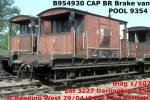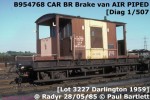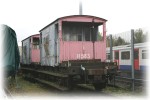| << Profile 20 >> |
BR-built Goods Brake Vans |




| Build Details: |
1949-1961 BR Faverdale/Swindon/Derby |
| Numbering: |
B950000-B955247 |
| Bogies / Suspension: |
|
| Dimensions: |
(BR standard) 27ft LOB, 16ft wheelbase |
| Published Drawings: |
|
| Areas of operation: |
Throughout UK |
| Main liveries: |
Various |
| Summary: |
For many years the goods brake van was a common sight almost everywhere in the UK, bringing up the rear of freight trains. BR built over 5000 vans but the widespread adoption of continuous braking (particularly air brakes) saw their numbers slashed and a mere handful survived into the 21st century. |
|
| History: |
NB: This is a brief profile. It will eventually be upgraded to the standard of later profiles, with more detailed information.
Goods brake vans were an integral part of the UK freight scene almost from the beginning, but have now dwindled to the point of extinction thanks to the standardisation on continuous brake fitted wagons and the streamlining of operational procedures. As the name suggests, these vans were intended to provide braking to goods train (in addition to that supplied by the locomotive), but they also allowed the train guard to travel at the rear, keeping an eye on things.
BR inherited a large number of brake vans from its precursor companies, and soon embarked on a building programme, initially divided between the existing LNER, LMS and GWR designs. The LNER type was evidently the most successful, as this was selected (with minor modfications) for all batches built from 1950. Out of a total of 5248 built by BR, 4922 were to the ex-LNER or BR diagrams.
The LNER and BR designs featured a 16ft long body, with short verandahs at each end, mounted on a 16ft wheelbase (24ft over headstocks) chassis. Two stepboards were fitted to each side (full length on the BR variant) while concrete or scrap metal weights were built into the chassis and ends to provide additional braking effort. Unfitted, vacuum-piped and vacuum-fitted examples were built.
The last BR standard brake vans were built in November 1962. However, London Transport ordered a batch of 6 in 1961 and these were constructed at Ashford. Sources differ as to whether these were completed in 1962 or 1965. These were to the final BR design (with roller bearings) and were given LT internal numbers of B580 to B585, being used on engineering trains on the sub-surface network. In 1980, B583 and B584 were modified to act as coupling adaptor wagons to allow the movement of London Underground stock on BR tracks. They were repainted grey, registered as private owner wagons LT95800 and LT95801 respectively and assigned TOPS code PXQ (KMQ from 1990). Although deregistered by 1999, and ommitted from recent stock listing books, the pair are still extant and can be seen from trains passing the depot at Ruislip, together with the other survivors; yellow-painted B580 and B585. Two former BR wagons from the final design were acquired by LT in the early 1990s (thought to be in connection with the use of preserved ex-BR locos and stock for special excursions on the Metropolitan line) and repainted red. These were also network-registered as private owner wagons, becoming LT95802 (ex B955112) and LT95803 (B955096). The fate of these wagons is not known. Finally, mention should be made that 13 BR brake vans were repainted in London Underground related liveries in 1990/1991, and used with similarly painted adaptor wagons converted from air-braked vans (see REA/RLA).
An incredibly detailed account of the construction, operation, liveries and history of the BR brake van fleet can be found in the book “British Railways Brake Vans and Ballast Ploughs” by Eric Gent published by The Historical Model Railway Society in 1999. At that time just 144 vans remained in stock, of which 92 were in traffic use (TOPS codes CAQ and CAR). Of the remainder, 35 were in use as engineers train brake vans (ZTO/ZTP/ZTR/ZTV), 9 as propelling warning vehicles (RAQ/RAR), 6 as coupling adaptors (RFQ) and 2 in other roles (ZPR/ZXQ). By the end of 2005, the fleet of active BR-built vans had shrunk to 18. |
|
| Queries: |
|
|
| References: |
|
|
| Links: |
Photos of diagram 1/500 Brake Vans on Paul Bartlett's website
Photos of diagram 1/502 (GWR-design) Brake Vans on Paul Bartlett's website
Photos of diagram 1/503 and 1/505 (LMS-design) Brake Vans on Paul Bartlett's website
Photos of diagram 1/504 Brake Vans on Paul Bartlett's website
Photos of diagram 1/506 Brake Vans on Paul Bartlett's website
Photos of diagram 1/507 Brake Vans on Paul Bartlett's website
Photos of Brake Vans on Martyn Read's website
|
|
| Updates: |
15/03/2013: Photo links (finally) updated.
03/12/2008: Photo of London Transport brake vans added.
|
|
| Photos |
| For more pictures see the Links section at the bottom |

B954930 in original condition at Reading West, 29th April 1984.
Paul Bartlett

CAR B954768 in air-piped livery, Radyr, 28th May 1985.
Paul Bartlett

CAR B954686 in Railfreight livery, Tees Yard, 11th August 1991.
Paul Bartlett

London Transport B583 and B584 at Acton on 2nd November 2008. Note that B583 carries the incorrect TOPS number LT95803
Damon Cross
|
|









